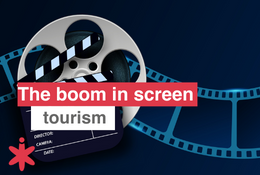The boom in screen tourism
The boom in screen tourism
Film tourism is not a new type of tourism. The tourism sector and the audiovisual sector have been closely linked for years.
Download the full report
An example of this phenomenon can be found in the famous film Braveheart (1995). A BBC article estimates that the Wallace Monument in Scotland went from recording 80,000 visitors per year to 180,000 after the release of the film. Twenty years later, in 2015, 35% of visitors said they had visited the monument influenced by the film. As can be seen, the influx of tourists to these sites endures over time.
In recent decades, however, the consumption of films and, above all, TV series has increased. The agency TCI Research stated that, in 2017, more than 80 million tourists chose their holiday destination based on films or TV series. This fact may be conditioned by the arrival of streaming platforms that have made it possible to consume audio-visual content from all over the world. In May 2021, the platforms with the most subscribers worldwide were Netflix, Amazon Prime and Disney+.
The locations that appear in films or series can arouse the interest of viewers and motivate them to travel to that destination, becoming tourists. Nowadays, with the great success of social networks, there are accounts dedicated exclusively to showing locations where films or series have been filmed, such as @filmtourismus (813k). This blogger creatively shows her trips to these places by holding up a photo of the exact scene in which they appear.

Perfil de Instagram de film tourism
Although visiting film locations is the most visible part of screen tourism, this type of tourism also comprehends other activities related to audio-visual productions, for example, film studio tours. Some of the most popular studios worldwide are Universal Studios Hollywood in California and Warner Bros. Studio Tour London – The Making of Harry Potter in England.
In the current era in which visual content is so important, being present in films or series is a fundamental marketing tool for tourist destinations. These territories carry out different actions to make their film tourism offer more attractive, such as film director routes or guided tours of filming locations. In this aspect, Film Commissions play a fundamental role. They are agencies that, among their functions, promote a specific destination as a filming location for audio-visual productions and promote film tourism.
A very relevant series from a tourism point of view is Game of Thrones (2011 – 2019) whose filming took place in different European countries such as Croatia, Iceland, Ireland and Spain. The advertising platform Criteo found a significant increase in bookings to these countries a few months before the premiere of the last season in 2019. Bookings to Iceland increased by 166% and those to Croatia by 68%. In Spain, scenes were filmed in different regions, in well-known locations such as the Real Alcázar in Seville and the Zafra Castle in Guadalajara. According to the tourism platform Tripadvisor, searches for the Zafra Castle on this portal increased by 488% in one year after its appearance in the series.
Our travel intelligence platform Travellyze states that 12% of Spanish tourists are inspired by films when they travel, a much higher percentage than the European average, which is half the European average. As for the profile of the Spanish tourist, this is a person between 26 and 45 years old without children. Influenced by films, the destinations they would like to visit are Italy and Norway.
Focusing on Spain as a film tourism destination, it is worth highlighting the large number of national and international productions filmed. Well-known productions such as Vicky Cristina Barcelona (2008), La Casa de Papel (2017 – 2021) or, as mentioned above, Game of Thrones has help to attract tourists to these locations.
A recent Netflix study shows an increase in people’s interest in Spain after viewing Spanish content. This increases interest in learning the language, getting to know the culture and visiting the country.
Over the last few months, there have been several initiatives related to screen tourism in Spain. The Spain Film Commission launched in the International Tourism Trade Fair (Fitur) 2021 the project “Spain Screen Grand Tour”. Its objective is to promote the creation of tourism products based on films or tv shows and to standardise film tours on a national level.
At the end of June, the collaboration between Turespaña and Netflix was announced in order to take advantage of the influence of audio-visual productions on viewers’ travel decisions and thus attract them by promoting Spain, as well as contributing to the country’s tourism recovery. Within this framework, a promotional video has been produced in which the platform shows Spanish series and films and the places where they were filmed. Spain is not the only country with which Netflix has collaborated on tourism. Last year, during the confinement, a similar video was made together with the Korea Tourism Organization (KTO) encouraging people to get to know the country virtually through its films and series.
Another project is the ‘Spain Audio-visual Hub of Europe’ developed by the Spanish Government which seeks to turn Spain into the main European audio-visual Hub by increasing the number of national productions, attracting investment and digitalising the sector. This can generate a rise of screen tourism in Spain.
To conclude, we can affirm that, whether recent or classic, films and tv shows make the audience interested in the locations they show, motivating them to travel there.
Elena Andrés Sánchez
Marketing Team





 All the news
All the news  Back to newsroom
Back to newsroom

